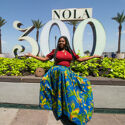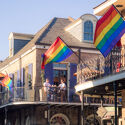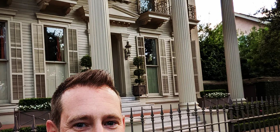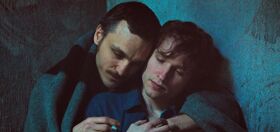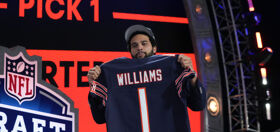
One of the best cities in the world is about to turn 300. New Orleans is gearing up for its tricentennial, and the year of celebrations will be epic.
There’s a million reasons everyone loves New Orleans and wants to visit–the food, the music, the people, the character–but one of the best is to take in and enjoy its thriving LGBTQ culture and scene. The city is often referred to as the “Gay Capital of the South,” and has a long history of not just accepting but actually embracing people from all walks of life.
Check out just a few of the ways historic New Orleans liberated queer culture, and how it continues to transform the lives of visitors today…
Mardi Gras
How about we take this to the next level?
Our newsletter is like a refreshing cocktail (or mocktail) of LGBTQ+ entertainment and pop culture, served up with a side of eye-candy.

Then: Mardi Gras has been a New Orleans tradition for literally hundreds of years. It started in the 1730s with prominent society figures hosting lavish balls in their homes. By the 1830s, regular people began planning their own parties and small street processions. The first official Mardi Gras parade was held in 1857.
Gay carnival krewes emerged in the 1950s. The very first one was called the Krewe of Yuga, sometimes referred to as “KY” (get it?), and poked fun at all those old, aristocratic Mardi Gras traditions. By the 1960s, there were over a dozen gay krewes and counting. The gay krewes reached their apex in the 1980s. Balls, masques, and other special events were held throughout carnival season and invitations were a hot commodity.

Now: Today, the gay krewes are going strong. In fact, this year, the Krewe of Armeinius will celebrate its 50th anniversary. The theme of this year’s ball is “300 Years of Fabulous,” in reference to the city’s tricentennial. The golden celebration will be held on Saturday, February 10, 2018.
Get your Mardi Gras fix year-round:
- Mardi Gras Museum upstairs at Arnaud’s: You won’t want to miss this priceless collection of costumes, jewelry and other Mardi Gras memorabilia inside one the French Quarter’s oldest restaurants.
- House of Dance and Feathers: Located in the historic Lower 9th Ward, this colorful museum celebrates the history of the Mardi Gras Indians, skull and bone gangs and New Orleans’ street culture.
- Backstreet Cultural Museum: This family-owned museum in Tremé houses costumes, artifacts, and other materials important to New Orleans’ African American culture, including Mardi Gras Indians, jazz funerals, social aid and pleasure clubs.
- Mardi Gras World: Every day is Mardi Gras at this tourist hot spot that provides visitors with a behind-the-scenes look at how Mardi Gras is brought to life.
Queer artistic heritage

Then: From playwright Tennessee Williams to author Truman Capote to photographer Frances Benjamin Johnston, New Orleans has a rich history of queer artists who helped create the welcoming culture. Williams, who lived there for 40 years, called the city his “spiritual home” and wrote some of his greatest works, including A Streetcar Named Desire, right in the French Quarter.
It was in New Orleans that Williams “found the kind of freedom I had always needed, and the shock of it – against the Puritanism of my nature – has given me a subject, a theme, which I have never ceased exploiting.” In fact, Williams’ apartment at 722 Toulouse Street served as inspiration for much of his work, including Vieux Carré.

Now: Today, you can visit the Williams building, which became part of the Historic New Orleans Collection that houses many of his original manuscripts, including a 1973 script Vieux Carré. The Tennessee Williams Theatre Company continues to honor the great American playwright’s legacy by mounting performances of his well-known and rarely produced plays. The Saints & Sinners Literary Festival, which happens every spring in conjunction with the Tennessee Williams Literary Festival, celebrates both emerging and leading voices literature. Then there’s the New Orleans Gay Men’s Chorus, founded in 1982, which hosts a dozen or so concerts annually.
The city is also the birthplace of contemporary entertainers, including comedian Ellen Degeneres, drag superstar Bianca del Rio, Queen of Bounce Big Freedia and crooner Frank Ocean.
Get your culture fix:
- Faulkner House Books: This charming bookshop is located along Pirate’s Alley in the French Quarter, just off Jackson Square, and is the former home of William Faulkner.
- The Twirl: A gay heritage and drinks tour: This walking tour of the French Quarter offers an insider’s view of the city’s rich history while exploring the classic watering holes de la vie en rose.
- The Edgar Degas House: Tour the historic home and studio of the famed French artist and Impressionist master.
- Hot Tin: Located on the Penthouse floor of the Pontchartrain Hotel on St. Charles Street, this swanky bar is named after the Williams’ play Cat On A Hot Tin Roof and offers a 270-degree view of Downtown New Orleans and the Mississippi River.
The historic neighborhoods

Then: The French Quarter (a.k.a.Vieux Carré) may be the oldest neighborhood in New Orleans, but just adjacent to it is Faubourg Marigny, historic in its own right. The area originally belonged to Creole landowner Bernard de Marigny, who divided it up into lots and sold them to developers in the early 1800s.
People were attracted to the area because of its affordable prices and proximity to the Quarter. Under the century-old live oaks, newcomers built Creole cottages and shotgun houses, many of which stand today, painted in the vibrant colors of the rainbow.
Over the years, several famous New Orleanian musicians grew up in the neighborhood or moved to the neighborhood as adults, including the legendary Jelly Roll Morton and Creole blues singer Lizzie Miles.

Now: The New Marigny Historic District was added to the National Register of Historic Places in 1994. Today it’s known for its cozy bistros and bohemian bars and jazz clubs, especially along Frenchmen Street. Sidewalk musicians and brass bands add to the party vibe of the neighborhood.
Other historic neighborhoods to visit:
- Faubourg Tremé: Still thriving after 200 years, this is America’s oldest African American neighborhood.
- Garden District: Known for its antebellum mansions and architecture, live oak trees, pristine gardens, and old-fashioned southern charm.
- Bayou St. John: Located on its namesake waterway, this cozy enclave is close to the Fairgrounds and City Park.
The festivals like Southern Decadence

Then: What started as a group of friends throwing a costume party one steamy afternoon in late August has grown into one of the wildest and widely-attended LGBTQ events in the South–or anywhere–in the world.
The inaugural event was held in 1972 and was billed as “Southern Decadence Party: Come As Your Favorite Southern Decadent.” Fifty or so people arrived dressed as their favorite Southern characters–Belle Watling, Tallulah Bankhead, and New Orleans’ own Ruthie the Duck Lady–then went on an impromptu drunken parade through the French Quarter. A year later, they met up and did it again, and again and again. Until…

Now: Southern Decadence attracts upwards of 250,000 people from all corners of the globe. The celebration is held over Labor Day weekend and includes non-stop circuit parties, bar crawls, and other special events, plus, of course, the parade through the French Quarter. The next Southern Decadence celebration happens Thursday, August 30, through Monday, September 3, 2018.
Other great LGBTQ events throughout the year:

- Halloween New Orleans: An annual weekend-long costume party benefitting Project Lazarus, an assisted-living home for those with HIV/AIDS in New Orleans.
- Gay Easter Parade: Held every year on Easter Sunday, this parade showcases the fashion and creativity of the local LGBTQ community and includes horse-drawn carriages, trolleys, brass bands, and lots of fabulous, home-made Easter bonnets.
- New Orleans Pride: A series of parties, parades, and other special events the third weekend in June.

